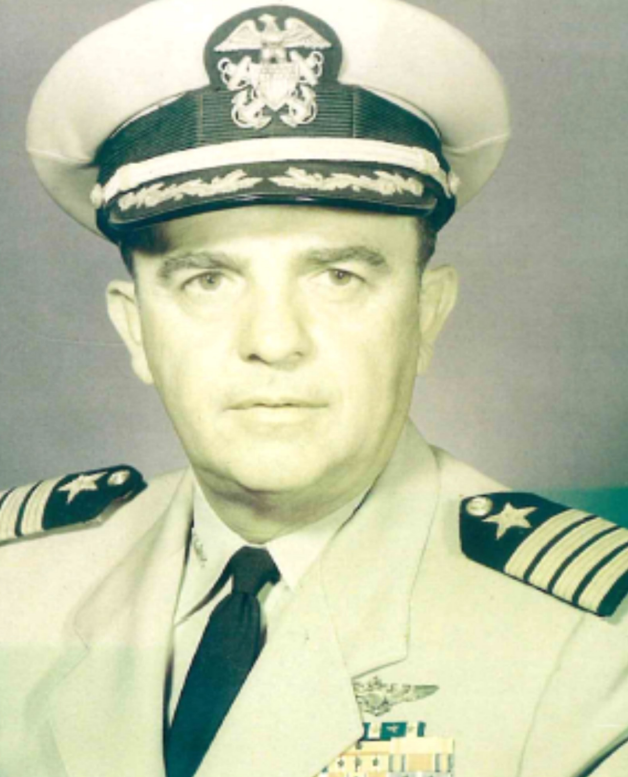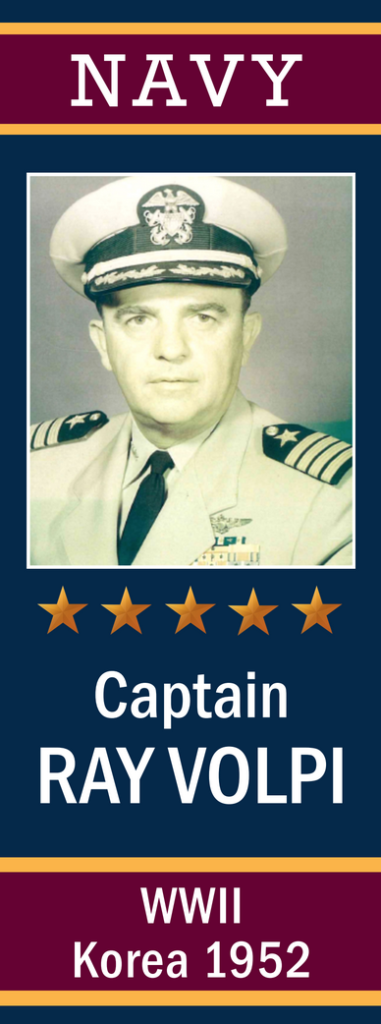
The Navy gave Captain Ray Volpi the rare distinction of seeing action in World War II, Korea, and Vietnam. Apart from those Navy years, Volpi spent all of his 93 years, in California
Volpi was born in Antioch, Ca, August 31, 1921. He graduated Tracy High School, as a true scholar-athlete, excelling in varsity football, basketball, and academics. He went on to attend the College of the Pacific, until the Japanese bombed Pearl Harbor, and the United States declared war on both, Japan, and Germany.
 Volpi heard the call of his country, and immediately left college to join the Navy, following the example of his brother. He entered flight training after he was commissioned an ensign, receiving his gold wings on April 10, 1943. Then, Volpi was assigned to fly missions off carriers in the Pacific theater for the duration of WW II.
Volpi heard the call of his country, and immediately left college to join the Navy, following the example of his brother. He entered flight training after he was commissioned an ensign, receiving his gold wings on April 10, 1943. Then, Volpi was assigned to fly missions off carriers in the Pacific theater for the duration of WW II.
Early in his career, Volpi flew missions off jeep (small) carriers. In one engagement with Japanese fighters, he shot down three of their planes. His squadron was active in the Marshalls, Palau, Marianas, and Leyte, helping to drive the Japanese forces from those islands.
Entering the Korean War, Commander Volpi led Fighter Squadron 24 off the carrier USS Boxer. Leading a strike over Hamhung, North Korea, the 24th repeatedly attacked a key railroad bridge until it was destroyed. Once the bridge collapsed, Volpi, and his fellow pilots, sought out and fired upon a large detachment of troops and supplies with their 20-mm cannons. After he ran out of ammunition, Volpi continued to make dummy runs over the enemy, pointing out targets to the other planes in the squadron, in spite of his air-craft having been hit by anti-craft fire. In receiving an award for his bravery in this action, the Navy commented It was probably one of the most outstanding displays of heroism since the start of the Korean War.
Because of Volpis experience in Grumman-Hellcat and Wildcat-fighter planes, he was called back from Korea to be a Navy test-pilot at an air station near St. Louis. Here, he flew the latest aircraft coming off the McDonnell-Douglas line.
Later Volpi became Assistant Air-Officer on USS Shangri-La. His renown as a fighter pilot gave him command of yet another Squadron , VF-52, on the carrier, USS Ticonderoga.
In 1961, Volpi was assigned to duty with the Seventh Fleet, based in Yokosuka, Japan, although most of his time in Asia was spent instructing Air Force fighter pilots at Naha, Okinawa.
In 1963, Volpi became the executive officer of USS Constellation, remaining on board until February, 1964. USS Constellation was a Kitty Hawkclass Super-carrier. She was the third ship of the United States Navy to be named in honor of the new constellation of stars on the United States flag, and the only vessel ever authorized to display red, white, and blue designation numbers. She was one of the fastest ships in the Navy, which was proven by her victory during a battlegroup race held in 1985, when she was nicknamed Connie by her crew and was officially distinguished as Americas Flagship. Connie was decommissioned in 2003, shortly after she participated in Operation Iraqi Freedom. For all of the 42 years, North Island was the carriers homeport.
Volpi then did a stint with the Chief of Naval Operations, until his departure to the Naval War College in Newport, RI. Here he received his certificate from the War College, as well as his Bachelor of Arts degree from George Washington University.
When the Vietnam War broke out, Volpi left the East coast for the West to assume command of the attack transport, USS Lanawee, a ship that ferried troops and supplies along the coast of Vietnam. In 1968, Volpi left the Lanawee for duty at the Naval Air Station North Island (NASNI) in Coronado where he was safety officer for the whole Pacific Naval Air Force.
As the Vietnam War wound down, after a 30-year career, Captain Ray Volpi retired from the Navy. The military awards he garnered during his service were the following: two Distinguished Flying Crosses; eight Air Medals; three Navy commendation Medals; Presidential Unit Citation; Philippine Unit Citation; Asiatic Pacific Service Medal; Korean Service Medal; National Defense Medal; Vietnam Service Medal; Armed Forces Expeditionary Medal.
Volpi spent the next 40 years living in Coronado CA; 25 of those years he spent in property and casualty insurance. He always focused on home, family, and he enjoyed golf. He was a long and loyal member of the Coronado Mens Golf Club. One member of the Golf Club remembered him fondly as, One of the most concerned persons in the Club. When anyone had a difficulty on the course, or in his life, Ray Volpi made himself available to him.
Volpis wife, Maria, preceded him in death in 2002. He joined her Feb. 20, 2015. They are both interred at Fort Rosecrans National Cemetery, in San Diego.
Note: Captain Ray Volpes bio can be seen at Fourth Street and D Avenue.
Next weeks Avenue of Heroes biography will be RADM James D. Jig Dog Ramage, USN (Ret).
To nominate someone for a Hero Banner, download and application from the City of Coronado Website or visit City Hall and pick one up. Upon submission, you will need a photograph and news article or DD214 form. The nominee should have lived in Coronado. A base address constitutes residency.
City of Coronado web banner address: http://www.coronado.ca.us/egov/apps/document/center.egov?view=item;id=8501
Also available on Avenue of Heroes Facebook Page.
Written by John Lepore




